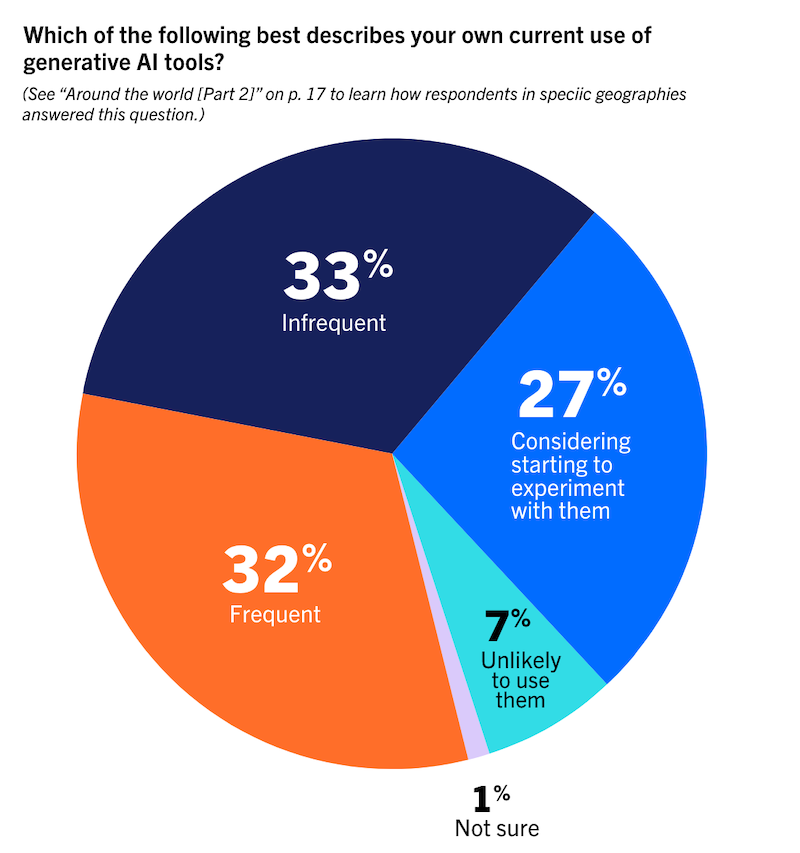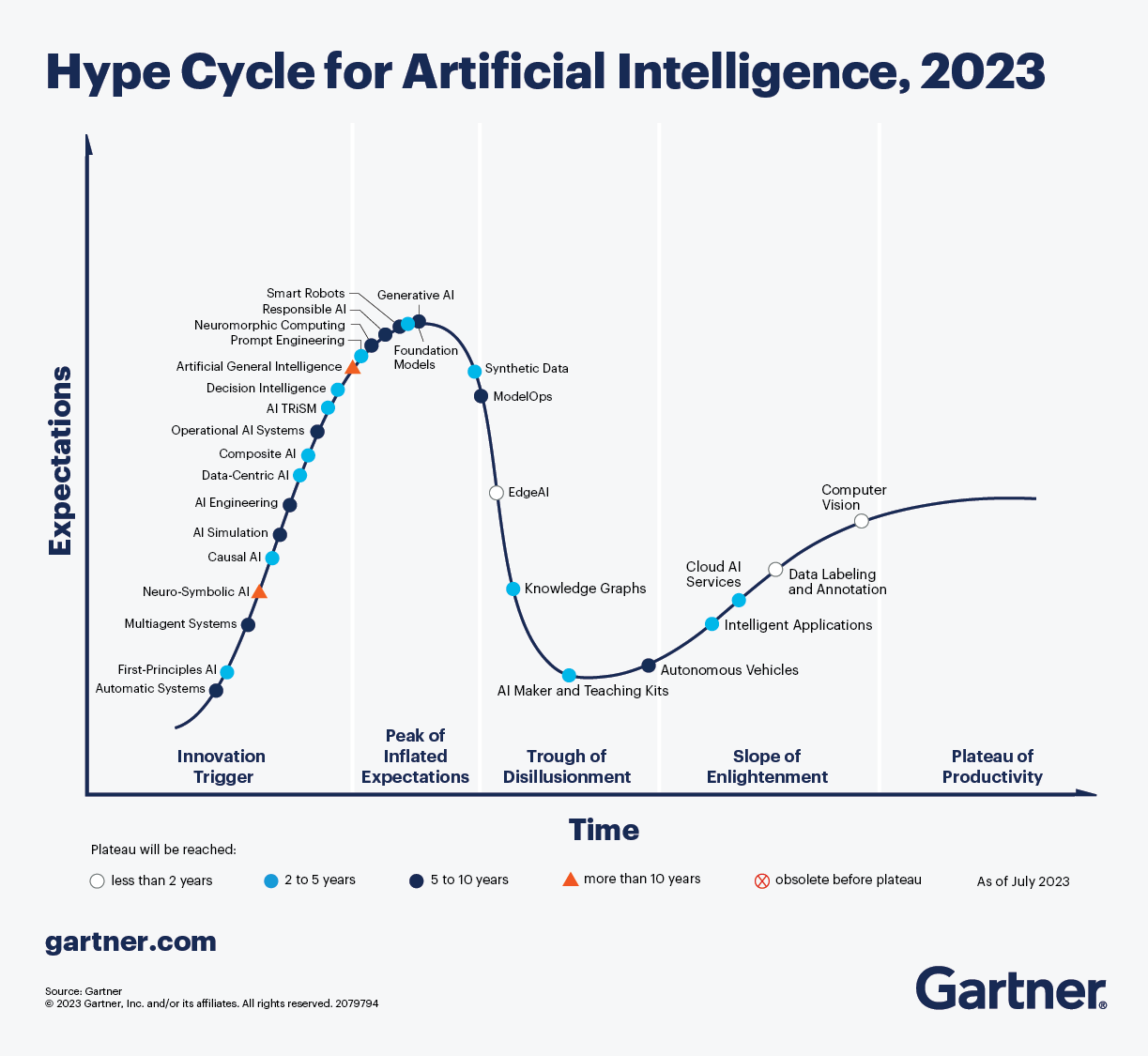I have been writing a small paper on the adoption of AI tools by Public Relations (PR) professionals. Online, it feels like everyone in the field is making use of AI tools but very few are clear in how they do it. Let’s take a step back here.
Quick story of AI in Public Relations
ChatGPT only came out in November 2022 (OpenAi, 2022) with the upgrade to version 4 a few months later (OpenAi, n.d.). Other tools like DALL-E and Stable Diffusion were already here and during this time took a huge leap forward.
It’s been less than a year and big companies quickly faced issues with copyright infringements (Appel et al., 2023), prompt injection1, privacy issues (ChatGPT Has a Big Privacy Problem | WIRED, n.d.), and other ethical concerns about the disclosure of using these tools. We also found that the training material for Large Language Models (LLLMs) is very biased (Walker Rettberg, 2022).
It is hard for someone to call themselves an expert on AI after just over a year. We did see a giant wave of new tools using AI and the OpenAI Application Protocol Interface (API), as of today (2024-01-22) there are 64 different tools listed on my bookmarks. Most of these tools offer a free tier that allows anyone to test them, so there is no problem of access.
Not all of these are meant for PR, and surely most of them will vanish, be acquired, or prove unreliable in some way.
Meanwhile, the CIPR was quick to respond. (AI in PR Guides, n.d.) (CIPR Report Finds AI Tools in Public Relations Set to Explode, n.d.) And the CIPR “Introduction to AI” actually dates back to 2019. (Valin Hon, 2019)
In this landscape we have two important step-stones to adopt AI in PR, guidance from a reputable source and access to tools. We’re left with an obstacle of digital literacy and realisation of what output generative AI2 can bring to PR. A point can be made that these tools are made mostly for consumer-level use, not all of them fulfil the requirements to be used safely by organisations. An example of this is are the leaks of private information through ChatGPT3.
We wont consider the lack of corporate tools as an obstacle for PR because we have already seen that the use of ChatGPT was sufficient to define a Blue Ocean Strategy (Olenick & Zemsky, 2023).
This raises the question of the ability of PR professionals to use these tools.
According to Zerfass et al. (2020), “communication professionals revealed a limited understanding of AI and expected the technology to impact the profession as a whole more than the way their organizations or they themselves work”.
In an article published in 2020 by Sónia Pedro Sebastião, the results are not encouraging for the Portuguese scenario.
(…) Portuguese respondents are among the least informed about AI in Europe, perceiving a greater impact with the adoption of AI in the way the communication and public relations professions will have to adjust (macro level). Requirements that are difficult to meet and may be obstacles to the adoption of AI by communication and public relations departments and agencies include the skills of these professionals (micro level). Finally, the biggest risks relate to the need for organizations to struggle with their employees’ skills gap and unclear responsibilities (micro level). (Sebastião, 2020)
Three years later, we hope that perceptions have changed, but a study by the PHC Foundation still warns that “39% of Portuguese fear Artificial Intelligence” (Fundação PHC, 2022). And to mark Digital Literacy Day in 2023, ANACOM highlighted the needs for training.
The European Commission’s global digital literacy indicator (Digital Skills Indicator 2.0) classified 29% of Portuguese individuals with a level above basic, 27% with the basic level, 24% below the basic level, 3% without level, and, finally, 18% as non-internet users – data referring to 2021.
Portugal occupied the 12th place in the EU27 ranking regarding the percentage of individuals with digital literacy above the basic level (29% in Portugal and 26% in the EU27 average).
ANACOM (2023)
Studies done before the ChatGPT boom might be one of the explanations for why, after a year, it is still not easy to find examples of AI use in PR.
AI Applied to PR, Concrete Examples in the Profession
One of the most practical and comprehensive works we found was the book Mastering Crisis Communication with ChatGPT: A Practical Guide, by Philippe Borremans (2023)
Focusing on the use of ChatGPT, Borremans describes practical examples of how to use this tool for typical Crisis Communication tasks.
- Content production,
- Generation of fictional scenarios,
- Generating reactive statements,
- Preparing role-play exercises (red teaming),
- Producing crisis communication plans.
Stephen Waddington conducted a similar exercise and concluded that AI can be useful in the following PR areas.
- Production of text and images
- Editing and summarizing
- Assessment and model creation
- Planning and Decision Making
Adapted from (S. Waddington, 2023, p. 5)
In a more concrete demonstration, the same author published a tutorial on how to use ChatGPT to follow all the steps of producing a press release (Waddington, 2023).
These authors do a good job of transposing the tools to the 4 stages identified by Cutlip et al. (2000).
- Research
- Planning
- Action / Communication
- Evaluation
It is important to mention that these two authors work in international contexts and the biases of ChatGPT work in their favor. Using these tools in a Portuguese context or a niche sector may not be so direct, but there are tactics to overcome this gap.
I was at this point in my paper, and convinced that our use of AI was still at early stages. The report by Cision put that into a more current perspective and went into how PR is using these tools.
 Source: 2024 Global Comms Report: Elevating & Evolving (p. 7). (n.d.). Cision and PR Week. Retrieved 31 January 2024, from https://www.cision.co.uk/resources/white-papers/2024-global-comms-report/2024-global-comms-report-download/
Source: 2024 Global Comms Report: Elevating & Evolving (p. 7). (n.d.). Cision and PR Week. Retrieved 31 January 2024, from https://www.cision.co.uk/resources/white-papers/2024-global-comms-report/2024-global-comms-report-download/
The chart above reflects the perspective of 427 senior level professionals across 10 countries, U.S., Canada, France, Germany, Sweden, U.K., Australia, China, Hong Kong, and Singapore.
Why aren’t we using more AI tools in Public Relations?
I was convinced that Cision’s report would prove me wrong in how slow we are to adopt new tools into the practice. That not being the case I am now wondering why we’re not doing more. A few possibilities come up.
- People in PR don’t have access to these tools or know how to use them.
- We still haven’t set up a process for AI use in-house and agency.
- AI doesn’t provide that much added value. It’s not Tony Stark’s J.A.R.V.I.S.
- AI still doesn’t have the level of quality humans provide.
- We’re at the peak of the inflated expectations of the Hype Curve.
- PR is a profession where sensitivity to stakeholders, publics, and context can’t be communicated to Large Language Models (LLMs).
1. People in PR don’t have access to AI tools
This isn’t really an issue, we have seen there is an abundance of tools and the real problem is that some of them promise more than they deliver. Some of these tools will also fade away, so there is a risk in relying too much on them.
2. We still don’t have a process for AI in Public Relations
PR already has a process, from research to evaluation of results. We can try to fit the tools to the process, or see where the AI can improve the output for the client. You can surely write a press release for a generic audience, AI can take it and create variations for different audiences or scan it to extract a fact sheet.
3. There’s not enough added value yet
Fiction made us believe AI would replace humans; the general response to ChatGPT’s launch by my online network was that AI would take away jobs from people not using AI to do their job better or faster.
Yet, with all the biases and uncertain quality of output from AI, it is only natural that we don’t feel that added value is present. We are still not at the level of Tony Stark’s AI Assistant who executes complex tasks on demand, and we won’t be there anytime soon. I have seen some experiments on creating an Auto-GPT, an autonomous AI that runs a series of tasks in an attempt to reach a described result. From my experiments using the open source version, it’s still in a very early stage.
4. AI still doesn’t have the level of quality humans provide.
This is my favourite. AI image generation still can’t draw hands, it gets confused with cables, and some of them are just too perfect to be realistic.

From my experience this also happens if you give ChatGPT a description of code you want it to produce. Descriptions that are too long are more prone to errors. The best approach is to provide small requirements, test, provide feedback, and keep any working version saved so we can go back and try with other requirements.
5. We’re at the peak of the inflated expectations of the Hype Curve
This argument is undeniable, Gartner itself presents in on their website.

Source: What’s New in Artificial Intelligence From the 2023 Gartner Hype CycleTM, August 2023.
6. PR is a profession where sensitivity to stakeholders, publics, and context can’t be communicated to Large Language Models
This is an inherited problem from the training material that was used for all sorts of Generative AI. To demonstrate, below we have a photo taken by Luís Pavão and the result of describing it to DALL-E using the prompt “generate a realistic black and white photo of two Portuguese men playing guitar in a dive bar where there is another man singing fado”.
The prompt provided could have been more thought out.
 Source for Luís Pavão: https://rr.sapo.pt/especial/vida/2024/02/01/luis-pavao-o-antropologo-urbano-que-fotografou-a-lisboa-que-se-evaporou/365045/
Source for Luís Pavão: https://rr.sapo.pt/especial/vida/2024/02/01/luis-pavao-o-antropologo-urbano-que-fotografou-a-lisboa-que-se-evaporou/365045/
The side-by-side speaks for itself, the resulting image is very polished, even disregarding the usual AI artificers with hands and arms that don’t match with reality.
Providing a reference photo kept the result consistent with the initial prompt and the usual caveats.

How can we accelerate the adoption of AI tools?
First we need to do a better job at identifying the concrete needs of the PR profession. Where are our pain points? Once those are identified we can look at the existing tools and filter out those who are mere interfaces to OpenAI’s tools. Most of all I feel we need to share more with the community. This should not be a race to find the best tool and gain competitive advantage, there is always a better tool around the corner, a new shiny object. My belief is that by sharing more we can provide better service, grow the profession, and make it rise to the C-level of companies.
Your thoughts?
References
2024 Global Comms Report: Elevating & Evolving (p. 22). (n.d.). Cision and PR Week. Retrieved 31 January 2024, from https://www.cision.co.uk/resources/white-papers/2024-global-comms-report/2024-global-comms-report-download/
AI in PR guides. (n.d.). Retrieved April 25, 2023, from https://www.cipr.co.uk/CIPR/Our_work/Policy/AI_in_PR_/AI_in_PR_guides.aspx
ANACOM. (2023). Dia Internacional da Literacia: Mais de metade dos indivíduos em Portugal tem literacia digital de nível básico ou superior - Destaques - Portal do Consumidor. https://www.anacom-consumidor.pt/-/dia-internacional-da-literacia-mais-de-metade-dos-individuos-em-portugal-tem-literacia-digital-de-nivel-basico-ou-superior
Appel, G., Neelbauer, J., & Schweidel, D. A. (2023, April 7). Generative AI Has an Intellectual Property Problem. Harvard Business Review. https://hbr.org/2023/04/generative-ai-has-an-intellectual-property-problem
Borremans, P. (2023). Mastering Crisis Communication with ChatGPT: A Practical Guide (PublishDrive edition). PublishDrive.
ChatGPT Has a Big Privacy Problem | WIRED. (n.d.). Retrieved January 22, 2024, from https://www.wired.com/story/italy-ban-chatgpt-privacy-gdpr/
CIPR report finds AI tools in public relations set to explode. (n.d.). CIPR Report Finds AI Tools in Public Relations Set to Explode. Retrieved April 25, 2023, from https://newsroom.cipr.co.uk/cipr-report-finds-ai-tools-in-public-relations-set-to-explode/
Cutlip, S. M., Center, A. H., & Broom, G. M. (2000). Effective Public Relations. Prentice Hall.
Fundação PHC. (2022). Estudo Literacia Digital 2022. Fundação PHC. https://www.fundacaophc.org/estudo-literacia-digital-2022
Greshake, K., Abdelnabi, S., Mishra, S., Endres, C., Holz, T., & Fritz, M. (2023). Not what you’ve signed up for: Compromising Real-World LLM-Integrated Applications with Indirect Prompt Injection (arXiv:2302.12173). arXiv. https://doi.org/10.48550/arXiv.2302.12173
Olenick, M., & Zemsky, P. (2023, November 24). Can GenAI Do Strategy? Harvard Business Review. https://hbr.org/2023/11/can-genai-do-strategy
OpenAi. (n.d.). GPT-4. Retrieved January 22, 2024, from https://openai.com/gpt-4
OpenAi. (2022, November 30). Introducing ChatGPT. https://openai.com/blog/chatgpt
Russell, S. J., Norvig, P., Chang, M., Devlin, J., Dragan, A., Forsyth, D., Goodfellow, I., Malik, J., Mansinghka, V., Pearl, J., & Wooldridge, M. J. (2022). Artificial intelligence: a modern approach (Fourth edition, global edition). Pearson.
Samsung Bans Generative AI Use by Staff After ChatGPT Data Leak. (2023, May 2). Bloomberg.com. https://www.bloomberg.com/news/articles/2023-05-02/samsung-bans-chatgpt-and-other-generative-ai-use-by-staff-after-leak
Sebastião, S. P. (2020). Inteligência Artificial? Não, obrigado.: Perceções dos Profissionais de Comunicação e Relações Públicas europeus. Media & Jornalismo, 20(36), Article 36. https://doi.org/10.14195/2183-5462_36_5
Valin Hon, J. (2019). Introduction to AI. https://cipr.co.uk/CIPR/CIPR/Our_work/Policy/AI_in_PR_/AI_in_PR_guides.aspx
Waddington. (2023, March 8). Hacking AI in PR: using AI tools to write a press release. https://www.wadds.co.uk/blog/2023/3/8/hacking-ai-in-pr-using-ai-tools-to-write-a-press-release
Waddington, S. (2023). The Impact of AI on Public Relations. Wadds Inc. https://www.wadds.co.uk/the-impact-of-ai-on-public-relations-management-paper
Walker Rettberg, J. (2022, December 6). ChatGPT is multilingual but monocultural, and it’s learning your values. Jill/Txt. https://jilltxt.net/right-now-chatgpt-is-multilingual-but-monocultural-but-its-learning-your-values/
What’s New in Artificial Intelligence From the 2023 Gartner Hype CycleTM. (n.d.). Gartner. Retrieved 1 February 2024, from https://www.gartner.com/en/articles/what-s-new-in-artificial-intelligence-from-the-2023-gartner-hype-cycle
Zerfass, A., Hagelstein, J., & Tench, R. (2020). Artificial intelligence in communication management: a cross-national study on adoption and knowledge, impact, challenges and risks. Journal of Communication Management, 24(4), 377–389. https://doi.org/10.1108/JCOM-10-2019-0137
Prompt injections are “attacks that circumvent content restrictions or gain access to the model’s original instructions” (Greshake et al., 2023) ↩︎
Generative AI refers to language models and image generators that are able to produce new output from their training data. By contrast, an inference model refers to AI methods, such as Machine Learning, that extract information from a large body of data. (Russell et al., 2022) ↩︎
“Samsung Bans Generative AI Use by Staff After ChatGPT Data Leak” (2023) https://www.bloomberg.com/news/articles/2023-05-02/samsung-bans-chatgpt-and-other-generative-ai-use-by-staff-after-leak ↩︎

